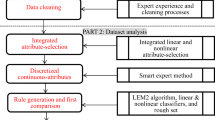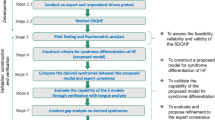Abstract
Objective
To analyze the diagnostic consistency of Chinese medicine (CM) specialists in patients with cardiovascular disease and to study syndrome classification and identification based on the multi-label learning method.
Methods
Using self-developed CM clinical scales to collect cases, inquiry information, complexity, tongue manifestation and pulse manifestation were assessed. The number of cases collected was 2,218. Firstly, each case was differentiated by two CM specialists according to the same diagnostic criteria. The consistency of the diagnosis based on Cohen’s Kappa coefficient was analyzed. Secondly, take the same diagnosis syndromes of two specialists as the results of the cases. According to injury information in the CM scale “yes” or “no” was assigned “1” or “0”, and according to the syndrome type in each case “yes” or “no” was assigned “1” or “0”. CM information data on cardiovascular disease cases were established. We studied CM syndrome classification and identification based on the relevant feature for each label (REAL) learning method, and the diagnostic rate of the syndrome was studied using the REAL method when the number of features selected was 5, 10, 15, 20, 30, 50, 70, and 100, respectively.
Results
The syndromes with good diagnostic consistency were Heart (Xin)-qi deficiency, Heart-yang deficiency, Heart-yin deficiency, phlegm, stagnation of blood and stagnation of qi. Syndromes with poor diagnostic consistency were heartblood deficiency and blood deficiency of Heart and Liver (Gan). The highest diagnostic rates using the REAL method were Heart-yang deficiency followed by Heart-qi deficiency. A different number of features, such as 5, 10, 15, 20, 30, 40, 50, 70, and 100, respectively, were selected and the diagnostic accuracy based on five features showed the highest diagnostic accuracy. The top five features which had a strong correlation with the syndromes were in accordance with the CM theory.
Conclusions
CM syndrome differentiation is strongly subjective and it is difficult to obtain good diagnostic consistency. The REAL method fully considers the relationship between syndrome types and injury symptoms, and is suitable for the establishment of models for CM syndrome classification and identification. This method can probably provide the prerequisite for objectivity and standardization of CM differentiation.
Similar content being viewed by others
References
Tsoumakas G, Katakis I. Multi-label classification: an overview. Intern J Data Warehousing Mining (IJDWM) 2007;3:1–13.
Zhou ZH, Zhang ML. Multi-instance multi-label learning with application to scene classification. Advances in neural information processing systems 19. Cambridge: MIT Press; 2007:1609–1616.
Shen XP, Boutell M, Luo JB, Brown C. Multi-label machine learning and its application to semantic scene classification. Pattern Recogn 2004;37:1957–1771.
Read J, Pfahringer B, Holmes G, Frank E. Classifier chains for multi-label classification. Machine Learning and Knowledge Discovery in Databases, European Conference, ECML PKDD 2009, Proceedings, Part II. Lecture Notes in Computer Science (Vol 5782). Springer; 2009:254–269.
Liu GP, Li GZ, Wang YL, Wang YQ. Modeling of inquiry diagnosis for coronary heart disease in traditional Chinese medicine by using multi-label learning. BMC Complement Altern Med 2010;10:37.
Wang YQ, Guo R, Yan JJ, Liu GP, Xu ZX, Yan HX, et al. Study the intelligent system of traditional Chinese medicine inquiry based on multi-label learning. The National Twelveth Academic Annual Meeting of Chinese Medicine Diagnosis, workshop, Ningxia, China; 2011:1–4.
Xu ZX, Wang YQ, Liu GP, Xu J, Li FF, Yan HX, et al. Clinical distribution of Chinese medicine syndromes on cardiovascular diseases. Modern Tradit Chin Med Mater Med-World Sci Technol (Chin) 2010;12:888–891.
Liu GP, Wang YQ, Dong Y, Zhao NQ, Xu ZX, Li FF, et al. Development and evaluation of an inquiry scale for diagnosis of heart system syndromes in traditional Chinese medicine. J Chin Integr Med (Chin) 2009;7:20–24.
Liu GP, Wang YQ, Guo R, Xu ZX, Li FF, Qian P, et al. The developing and evaluation of inquiry collecting system for Chinese medicine heart system. Modern Tradit Chin Med Materia Med-World Sci Technol (Chin) 2008;10(5):16–20.
Cardiovascular Institute of Integrative Medicine. Criteria for differentiation diagnosis of chest pain or chest choking, palpitation, short breath or lacking in strength for cardiovascular diseases in Chinese medicine. Qingdao, China; 1990:216–223.
Zhang BY, ed. Textbook of Chinese medicine internal medicine. Shanghai: Shanghai Press of Science and Technology; 1985:103–111.
Wang YQ, ed. Textbook of traditional Chinese medicine diagnostics (seven-year-version). Beijing: Higher Education Press; 2006:400–446.
Yu CH, ed. SPSS and statistical analysis. Beijing: Publishing House of Electronics Industry; 2007:623–625.
Zhang ML. LIFT: Multi-label learning with label-specific features. Proceedings of the 22nd International Joint Conference on Artificial Intelligence (IJCAI’11). Barcelona: Spain Press; 2011:312–320.
Liu GP, Yan JJ, Wang YQ, Fu JJ, Xu ZX, Guo R, et al. Application of multi label learning Using the relevant feature for each label in chronic gastritis syndrome diagnosis. Evid Based Complement Altern Med 2012;2012:135387.
Xu ZX, Wang YQ, Yan JJ, Li FF, Yan HX, Xu J, et al. Researching the recognition on TCM syndrome of cardiovascular disease based on SVM and ANNs. J Beijing Univ Chin Med (Chin) 2011;34:539–541.
Ferreira AS. Diagnostic accuracy of pattern differentiation algorithm based on Chinese medicine theory: astochastic simulation study. Chin Med 2009;4:24.
Author information
Authors and Affiliations
Corresponding author
Additional information
Supported by the National Natural Science Foundation of China (No. 81173199)
Rights and permissions
About this article
Cite this article
Xu, Zx., Xu, J., Yan, Jj. et al. Analysis of the diagnostic consistency of Chinese medicine specialists in cardiovascular disease cases and syndrome identification based on the relevant feature for each label learning method. Chin. J. Integr. Med. 21, 217–222 (2015). https://doi.org/10.1007/s11655-014-1822-6
Received:
Published:
Issue Date:
DOI: https://doi.org/10.1007/s11655-014-1822-6




